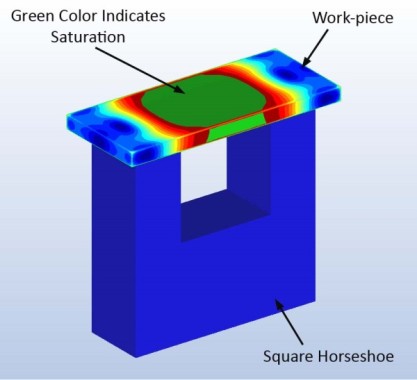|
Article
|
Saturation usually occurs in thinner workpieces where there is less volume of material to act on. Oftentimes, the entire workpiece does not saturate and there is actually a gradient within the workpiece with only portions being driven into saturation. Even though the entire workpiece does not saturate, the force is still limited because the non-saturating areas are not contributing to the attractive force.

Directly measuring the degree of saturation within a material can be difficult as this is an internal phenomenon. There are, however some first order methods which may indicate a system is in saturation. One option is to inspect the non-working face of the workpiece (the face which is opposite of the externally applied magnetic field) and try to observe any field “leaking” through. The degree of the leakage is a good indicator of saturation and suggests the workpiece would benefit from being thicker. The other option is to increase the workpiece’s thickness and see what effect it has. If one doubles the thickness of the workpiece and receives a measurable increase in attractive force, then the original workpiece was saturating, however, there is a point of diminishing returns. Increasing the thickness of a workpiece is generally always beneficial, but it will impact cost, mass, and possibly ease of manufacturing.
In conclusion:
- Saturation can negatively impact a design by lowering the overall magnetic efficiency of the system.
- Saturation of a material can be thought of the limit at which the material can carry magnetic flux. A pipe analogy works well as there is a limit to the volume of material carried by a pipe a there is a limit of magnet field a material can carry.
- There is a limit to how much induced magnetism is possible in a material. When no more internal magnetism can be created within a material, it is said to be saturated.
- Saturation is a fluid condition which is dependent upon the material’s magnetic characteristics and the intensity and direction of the applied magnetic field.
- Thinner workpieces usually suffer from saturation more than thicker workpieces.
- Magnetic saturation in the workpiece limits the effective attractive force between the workpiece and a magnet.
|